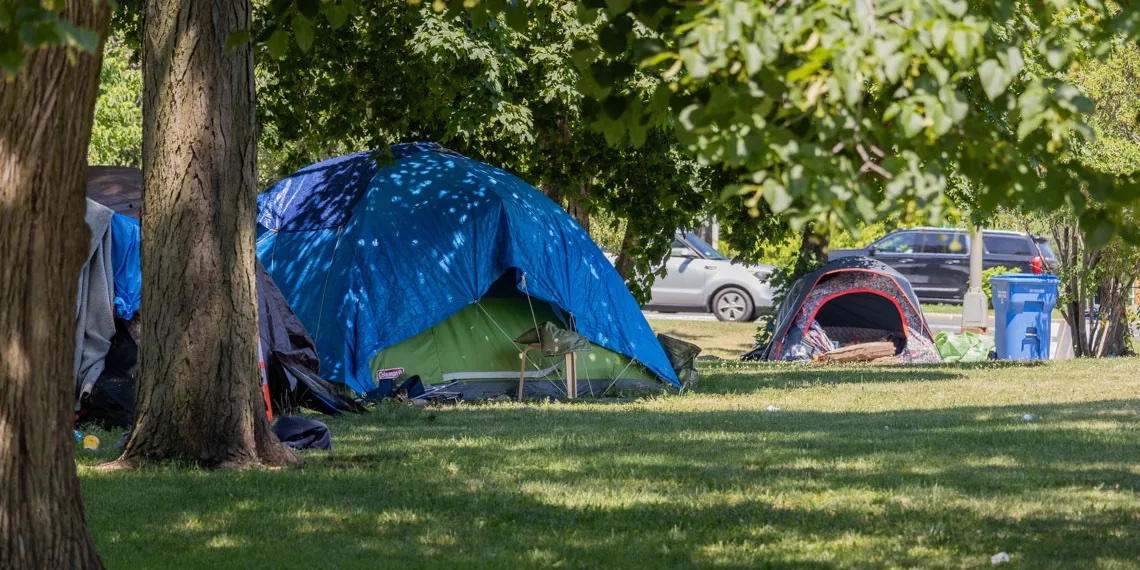Article Summary
- Illinois fiscal year 2026 budget reduced funding for programs serving homeless people by more than $14 million from the previous year.
- JB Pritzker s Home Illinois initiative aimed at reaching functional zero homelessness saw a $26.6 million cut.
- That program was launched in 2022 and had previously been on a steady upward funding trend.
- Advocates worry the reductions and potential federal cuts will exacerbate homelessness in Illinois, which increased 116% in 2024, according to state data.
The reporters and editors who worked on this story wrote this synopsis.
Illinois is seeing an increase in the number of homeless persons, yet the state is spending less on housing programs and homeless prevention.
The $55.1 billion fiscal year 2026 budget, which went into effect on July 1, cuts overall funding for housing programs—including Pritzker’s signature initiative to end homelessness in Illinois—by more than $14 million in the face of a tight budget year with limited natural revenue growth and constrained spending.
Doug Kenshol, co-founder of the Illinois Shelter Alliance, told Capitol News Illinois that the state of Illinois had a 116% increase in homelessness last year. It was quite disheartening to be in the middle of this crisis and then have the state reduce support.
The governor’s office claims that although overall spending increased by $2 billion in the FY26 budget, discretionary spending increased by less than 1%. Legislators cut a number of programs as a result of that meager funding increase.
Is it sufficient? Sen. Adriane Johnson, D-Buffalo Grove, who is a member of a state task committee on homelessness prevention, told Capitol News Illinois that the state of Illinois takes homelessness seriously and that it is an existential catastrophe. We intend to keep moving forward with our ambitious plan to eradicate homelessness.
Spending reductions
By executive order in 2021, Pritzker first created a task committee to develop a plan for Home Illinois to reduce homelessness in the state to functional zero, where those without housing can easily access housing options and homelessness is transient. Funding for the Home Illinois program is dropping by $26.6 million in FY26, and the executive order did not specify when the state will reach functional zero.
Prior to this, the Pritzker administration had prioritized housing programs for significant increases in recent years. Home Illinois received $263.7 million in the FY26 budget, compared to $290.3 million in FY25. This represented an increase of $90 million over FY24, when the program got $200.3 million in its first year following Pritzker’s signing of legislation in 2023 that codified the Home Illinois program and task committee.
See also: Pritzker approves a $55.1 billion state budget that depends on $700 million in extra taxes
A $25 million cut to the Court-Based Rental Assistance Program, which offers financial relief to those facing eviction, is one of the spending cuts in Home Illinois. Funding for other initiatives remained constant or expanded, such as shelters, which grew to support Chicago’s One System Initiative, which incorporates migrants into the city’s standard shelter system.
The advocacy group Housing Action Illinois reports that overall spending on housing initiatives has decreased. In the FY26 budget, total spending on housing programs decreased by $14.6 million to $354 million, however increases in several housing programs compensated for cuts to Home Illinois. Pritzker’s budget proposal had asked for a reduction of $7.6 million.
According to a statement from the Illinois Department of Human Services, FY26 is mostly a year of budget maintenance. Our dedication to promoting policies that prevent and eradicate homelessness throughout Illinois is unwavering.
Johnson stated that the state is still working toward long-term objectives that would call for additional financing, and that the budget cut is only temporary.
In an interview, Bob Palmer, the policy director for Housing Action Illinois, stated that the state is making every effort to make the most of its limited resources.
Palmer claimed that several of the ways lawmakers funded programs also shifted funds from one area to another. For instance, funds in the Affordable Housing Trust Fund are being used to boost funding for emergency or transitional housing even though the fund’s primary purpose is to finance new permanent rental homes.
Palmer stated, “We were somewhat happy to see that increase, but we also felt conflicted because it’s taking money away from another important housing resource.” We had been arguing that general revenue dollars should be used to pay for that increase.
See also: Illinois Shelter Alliance requests a $100 million increase in state assistance to combat homelessness
Although it was a minor victory for advocates, the $7 million boost in funding for the emergency and transitional housing program was far less than the $40 million increase that the Illinois Shelter Alliance had requested. The group urged Congress to provide housing projects an additional $100 million in financing overall.
Palmer was also concerned that the state budget would be further burdened by the projected federal cuts to rental assistance programs.
Homelessness continues to grow
Despite the new program, homelessness in Illinois is still on the rise, which is why the expenditure cuts were made.
Illinois had 25,787 homeless people on the night of the annual point-in-time count in January 2024, a 116% rise from 2023, according to the most recent data on homelessness in the state, which was released in October by a Department of Human Services task force.
Migrants sent to Illinois from other states, like Texas, are mostly responsible for the surge. 13,891 of the homeless in January 2024 were recent arrivals. Nonetheless, homelessness among non-migrants continues to climb, rising by 22% in 2024.
Additionally, the number of homeless people in the state is rising. In Chicago, it has increased by 207% since 2020, whilst the only counties in Illinois to have a decrease during that period were DuPage and St. Clair.
Johnson stated that although we can always improve, Illinois is headed in the right direction.
According to Kenshol, Home Illinois is having an impact even though the number of homeless people has increased since its founding.
They’ve developed some fantastic programs, dispersed monies, and built a lot of housing and shelter, but we need to continue that work and keep making small improvements because we’re not there yet, he said.
IDHS says the data supports that. 7,500 households have benefited from the Court-Based Rental Assistance Program, which was significantly reduced this year. Additionally, in the first part of FY25, Home Illinois served almost 18,000 people. 10,000 more people were assisted in FY22 than under IDHS’s previous homelessness prevention program.
Advocates and IDHS say the issue is the fast rising cost of housing, which makes it harder for more individuals to secure long-term accommodation and pay their rent. According to a report released last month by the Illinois Economic Policy Institute, Illinois needs an additional 142,000 housing units to keep up with the state’s existing housing demand.
Finding more resources
Service providers still require significant resources to address homelessness, according to data in the task force’s annual report that offers a roadmap for Home Illinois. Although the state now has over 23,000 beds and housing units for the homeless, an additional 27,000 are needed.
According to the task group, which consists of legislators, advocates, and senior officials from state agencies, if these resources are not addressed, the issue will only get worse.
Since homelessness is a dynamic systems problem—that is, the annual unmet need for shelter and housing may be expected to increase each year that the need is unmet—the longer it takes to fulfill these targets, the more resources will be required to attain functional zero, according to the report.
Palmer concurred.
“We must provide the additional resources to eradicate that shortage if we are serious about preventing and ending homelessness in Illinois; otherwise, we are only managing homelessness at its current level,” he stated.
“Regardless of the state’s budget situation, lawmakers should be increasing funding for housing because housing insecurity can be a root cause of other issues that cost the state more money, like health problems,” Palmer said.
According to Kenshol, a co-founder of Shelter Aliance, increasing funds for shelters alone is also insufficient. Increasing rental assistance programs to help keep people out of shelters should be a budget priority, he added, because a lack of financing for affordable permanent housing keeps individuals locked in the system.
Kenshol contended that the state should be able to find the funds to raise housing program financing annually in a budget of $55.1 billion.
We make various decisions as a society, as voters, and as elected authorities. According to Kenshol, we invest in other things while ignoring those who are in need and in danger of dying. According to my ideals, we should prioritize helping the less fortunate.
Hundreds of news outlets throughout the state receive coverage from the state government through Capitol News Illinois, a nonprofit, unbiased news organization. It is funded primarily by the Illinois Press Foundation and the Robert R. McCormick Foundation.
Thisarticlefirst appeared onCapitol News Illinoisand is republished here under aCreative Commons Attribution-NoDerivatives 4.0 International License.












